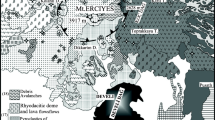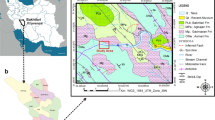Abstract
In order to estimate the strength parameters of rock, as the direct method by conducting rock mechanical tests is time-consuming and expensive, an indirect method based on soft computing technique is proposed. Least squares support vector machine (LS-SVM) is utilized to develop rock uniaxial compressive strength (UCS) and shear strength (SS) prediction models by considering indirect parameters such as rock density, point load strength, P-wave velocity and slake durability index. The results show that according to the rock physical and mechanical parameters of four rock types, empirical relationships based on statistical regression method are rock type specific, only linear relations existed between point load strength and rock strengths are acceptable with high determination coefficients for whole rock types. The LS-SVM models built for rock UCS and SS prediction have greater determination coefficients than the regression models. The prediction values based on LS-SVM prediction models for rock UCS and SS are both extremely close to the measured values, which indicates the applicability of LS-SVM is supported for estimation of strength parameters of rock.






Similar content being viewed by others
References
Armaghani DJ, Amin MFM, Yagiz S et al (2016a) Prediction of the uniaxial compressive strength of sandstone using various modeling techniques. Int J Rock Mech Min Sci 85:174–186
Armaghani DJ, Mohamad ET, Hajihassani M et al (2016b) Appliacation of several non-linear predictions tools for estimating uniaxial compressive strength of granitic rocks and comparison of their performances. Eng Comput 32(2):189–206
Basu A, Aydin A (2006) Predicting uniaxial compressive strength by point load test: significance of cone penetration. Rock Mech Rock Eng 39(5):483–490
Baykasoglu A, Gullu H, Canakci H et al (2008) Predicting of compressive and tensile strength of limestone via genetic programming. Expert Syst Appl 35(1–2):111–123
Beiki M, Majdi A, Givshad AD (2013) Application of genetic programming to predict the uniaxial compressive strength and elastic modulus of carbonate rocks. Int J Rock Mech Min Sci 63:159–169
Cao SG, Liu YB, Wang YP (2008) A forecasting and forewarning model for methane hazard in working face of coal mine based on LS-SVM. J China Univ Min Technol 18(2):172–176
Ceryan N, Okkan U, Kesimal A (2013a) Prediction of unconfined compressive strength of carbonate rocks using artificial neural networks. Environ Earth Sci 68(3):807–819
Ceryan N, Okkan U, Samui P et al (2013b) Modeling of tensile strength of rocks materials based on support vector machines approaches. Int J Numer Anal Meth Geomech 37(16):2655–2670
Dehghan S, Sattari G, Chehreh CS et al (2010) Prediction of uniaxial compressive strength and modulus of elasticity for Travertine samples using regression and artificial neural networks. Min Sci Technol 20(1):41–46
Fattahi H (2016) Application of improved support vector regression model for prediction of deformation modulus of a rock mass. Eng Comput. doi:10.1007/S00366-016-0433-6
Fener M, Kahraman S, Bilgil A et al (2005) A comparative evaluation of indirect methods to estimate the compressive strength of rocks. Rock Mech Rock Eng 38(4):329–343
Heidari M, Khanlari GR, Kaveh MT et al (2012) Prediction the uniaxial compressive and tensile strengths of gypsum rock by point load testing. Rock Mech Rock Eng 45(2):265–273
Kahraman S (2001) Evaluation of simple methods for assessing the uniaxial compressive strength of rock. Int J Rock Mech Min Sci 38(7):981–994
Kahraman S, Fener M, Kilic CO (2016) A preliminary study on the conversion factor used in the prediction of the UCS from the BPI for pyroclastic rocks. Bull Eng Geol Environ 75(2):771–780
Madhubabu N, Singh PK, Kainthola A et al (2016) Prediction of compressive strength and elastic modulus of carbonate rocks. Measurement 88:202–213
Mert E (2014) An artificial neural network approach to assess the weathering properties of sancaktepe granite. Geotech Geol Eng 32(4):1109–1121
Mishara DA, Basu A (2012) Use of the block punch test to predict the compressive and tensile strength of rocks. Int J Rock Mech Min Sci 51:119–127
Mishara DA, Basu A (2013) Estimation of uniaxial compressive strength of rock materials by index tests using regression analysis and fuzzy inference system. Eng Geol 160:54–68
Mohamad ET, Armaghani DJ, Momeni E et al (2015) Prediction of the unconfined compressive strength of soft rocks: a PSO-based ANN approach. Bull Eng Geol Environ 74(3):745–757
Moradian ZA, Behnia M (2009) Predicting the uniaxial compressive strength and static Young’s modulus of intact sedimentary rocks using the ultrasonic test. Int J Geomech 9(1):14–19
Rezaei M, Majdi A, Monjezi M (2012) An intelligent approach to predict unconfined compressive strength of rock surrounding access tunnels in longwall coal mining. Neural Comput Appl 24(1):233–241
Sachpazis CI (1990) Correlating Schmidt hardness with compressive strength and Young’s modulus of carbonate rocks. Bull Int Assoc Eng Geol 42(1):75–83
Sarkar K, Tiwary A, Singh TN (2010) Estimation of strength parameters of rock using artificial neural networks. Bull Eng Geol Environ 69(4):599–606
Sharma PK, Singh TN (2008) A correlation between P-wave velocity, impact strength index, slake durability index and uniaxial compressive strength. Bull Eng Geol Environ 67(1):17–22
Singh TN, Verma AK (2012) Comparative analysis of intelligent algorithms to correlate strength and petrographic properties of some schistose rocks. Eng Comput 28(1):1–12
Singh TN, Kainthola A, Venkatesh A (2012) Correlation between point load index and uniaxial compressive strength for different rock types. Rock Mech Rock Eng 45(2):259–264
Singh PK, Tripathy A, Kainthola A et al (2016) Indirect estimation of compressive and shear strength from simple index tests. Eng Comput. doi:10.1007/s00366-016-0451-4
Tan YF, He L, Wang XL et al (2014) Tribological properties and wear prediction model of TiC particles reinforced Ni-base alloy composite coatings. Trans Nonferrous Met Soc China 24(8):2566–2573
Torabi KM, Naseri F, Saneie S et al (2015) Application of artificial neural networks and multivariate statistics to predict UCS and E using physical properties of Asmari limestone. Arab J Geosci. 8(5):2889–2897. doi:10.1007/s12517-014-1331-0
Ulusay R, Hudson JA (2007) The complete ISRM suggested methods for rock characterization, testing and monitoring: 1974-2006. ISRM Turkish National Group, Ankara
Xu JC, Ren QW, Shen ZZ (2015) Prediction of the strength of concrete radiation shielding based on LS-SVM. Ann Nucl Energ 85(8):296–300
Yagiz S (2009) Predicting uniaxial compressive strength, modulus of elasticity and index properties of rocks using the Schmidt hammer. Bull Eng Geol Environ 68(1):55–63
Yilmaz I, Yuksek G (2009) Prediction of the strength and elasticity modulus of gypsum using multiple regression, ANN, and ANFIS models. Int J Rock Mech Min Sci 46(4):803–810
Acknowledgements
This study was sponsored by the National Natural Science Foundation of China (Grant No. 51574015). The authors would like to thank anonymous reviewers for their valuable comments and suggestions.
Author information
Authors and Affiliations
Corresponding author
Rights and permissions
About this article
Cite this article
Li, W., Tan, Z. Research on Rock Strength Prediction Based on Least Squares Support Vector Machine. Geotech Geol Eng 35, 385–393 (2017). https://doi.org/10.1007/s10706-016-0114-7
Received:
Accepted:
Published:
Issue Date:
DOI: https://doi.org/10.1007/s10706-016-0114-7




